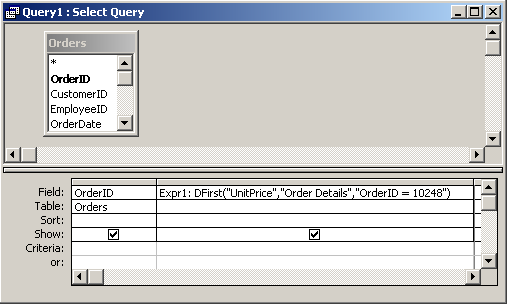
MS Access: DFirst Function
This MSAccess tutorial explains how to use the Access DFirst function with syntax and examples.
Description
The Microsoft Access DFirst function returns the first value from an Access table (or domain).
Syntax
The syntax for the DFirst function in MS Access is:
DFirst ( expression, domain, [criteria] )
Parameters or Arguments
- expression
- The field from which you want the first value.
- domain
- The set of records. This can be a table or a query name.
- criteria
- Optional. It is the WHERE clause to apply to the domain.
Returns
The DFirst function returns any datatype such as a string, numeric, date, etc.
Applies To
The DFirst function can be used in the following versions of Microsoft Access:
- Access 2019, Access 2016, Access 2013, Access 2010, Access 2007, Access 2003, Access XP, Access 2000
Example
Let's look at how to use the DFirst function in MS Access:
DFirst("UnitPrice", "Order Details", "OrderID = 10248")
In this example, you would retrieve the first UnitPrice value in the Order Details table where the OrderID is 10248.
Example in VBA Code
The DFirst function can be used in VBA code in Microsoft Access.
For example:
Dim LTotal As Currency
LTotal = DFirst("UnitPrice", "Order Details", "OrderID = 10248")
In this example, the variable called LTotal would now contain the first UnitPrice from the Order Details table where the OrderID is 10248.
Example in SQL/Queries
You can also use the DFirst function in a query in Microsoft Access.
For example:

In this query, we have used the DFirst function as follows:
Expr1: DFirst("UnitPrice","Order Details","OrderID = 10248")
This query will return the OrderID value from the Orders table. It will also return the first UnitPrice value from the Order Details table where the OrderID is equal to 10248. (NOTE: The Order Details table contains one record for each item ordered, so there can be more than one record for each OrderID). The results of the DFirst function will be displayed in a column called Expr1. You can replace Expr1 with a column name that is more meaningful.
For example:
FirstValue: DFirst("UnitPrice","Order Details","OrderID = 10248")
The results would now be displayed in a column called FirstValue. This example is just used for demonstration purposes to show how to use the DFirst function and what it would return.
Advertisements



